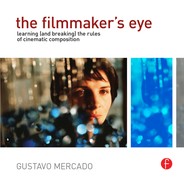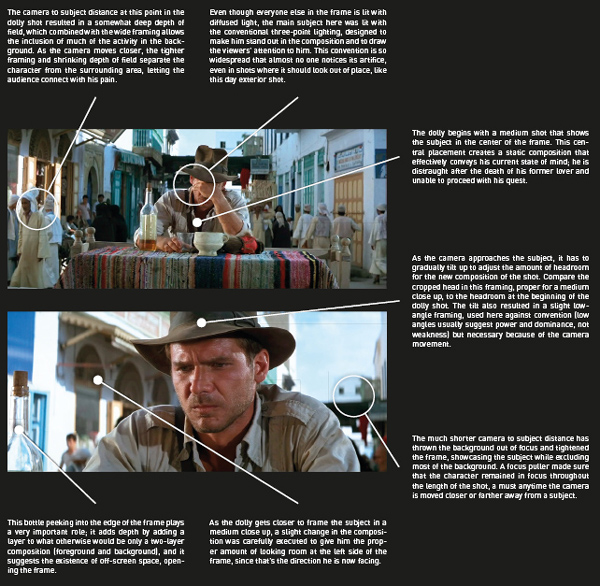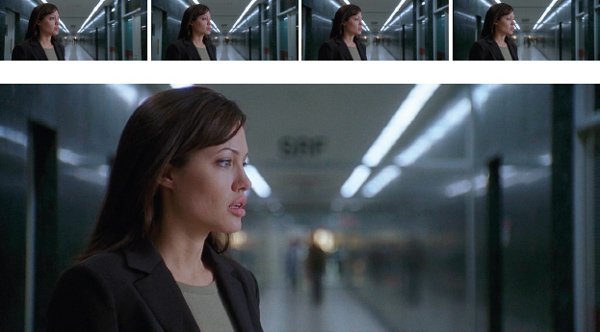dolly shot
Dolly shots are accomplished by placing the camera on a wheeled platform that can be moved smoothly. Although similar to a zoom shot (both shots create a dynamic frame with a constantly changing composition along the z axis), there are fundamental differences between them. In a zoom shot, the camera remains stationary while the focal length of the lens is shifted so the changes in framing are perceived by the audience as if an aspect of the composition is brought closer or moved away from them. Since the dolly shot physically moves the camera while the focal length remains constant, there is a constant change in perspective in the composition, resulting in the audience feeling as if they are the ones moving toward or away from an aspect in the frame. Dolly shots, like all moving camera shots, can be used to reveal, conceal, or comment on an action or situation. An extremely common use of the dolly shot is called the “dolly in,” where the camera is brought increasingly closer to the face of a character as he or she makes a meaningful discovery or has to make an important decision. Using a dolly shot instead of cut (to a tighter framing of the face) allows the tension, suspense, and drama of this moment to unfold gradually in real time, while the dynamic composition visually underlines it and makes it stand out from the rest of the scene. Used this way, the dolly shot adds a narrative context that would not be there if only static shots were used, as if commenting on the importance of the moment. Another common use of the dolly shot is the “dolly out” where the camera slowly moves away from a character, usually after an undesirable event has just taken place. The increasingly wider framing in this shot makes the character look gradually smaller in the frame, often indicating a loss of confidence, power, or increasing loneliness or despair. Dolly shots can also be used to reveal an important aspect of a scene that was initially concealed (or vice versa), often accompanying a character who experiences the revelation; the dynamic composition highlights the narrative importance of the discovery, and allows the audience to participate in that experience in real time with the character. Because of the strong visual and narrative statements they can make, dolly shots should be used sparingly, reserved for those moments in the story where the audience should make a strong connection with a situation or a character.
An excellent example of a dolly shot that both reveals an important aspect of a scene and comments on it happens in Lynne Ramsay’s Ratcatcher (1999), the harrowing tale of a 12 year old boy, James (William Eadie), who comes of age in an impoverished area of Glasgow in the 1970s. After sneaking away on a bus, he arrives at a partially completed housing project set in an idyllic section of the countryside. Inside one of the houses, the camera slowly dollies in to a window as James approaches it, to then follow after him as he jumps out into a wheat field, in one the film’s most beautifully surrealistic images. The dolly move gradually reveals the vastness of the field and allows the audience to experience, through the movement of the camera, the exhilaration and magic of this meaningful moment in James’ life.
A dolly in visually underlines a surrealistically beautiful moment in the life of James, a 12 year old growing up in an impoverished area of Glasgow, in Lynne Ramsay’s Ratcatcher (1999).
dolly shot
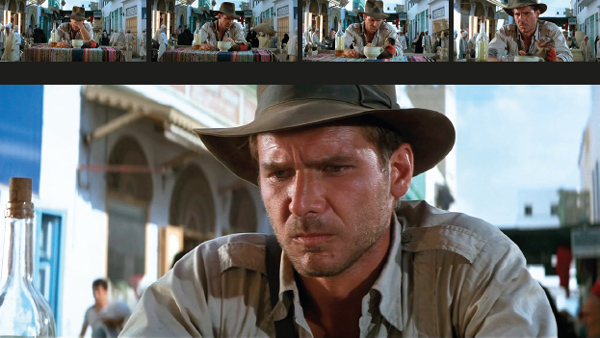
why it works
One of the most common uses of the dolly shot is as a “dolly in,” creating an increasingly tighter framing of a character’s face to underline a meaningful moment of discovery or reflection, as seen in this dolly shot from Steven Spielberg’s Raiders of the Lost Ark (1981). Indiana Jones (Harrison Ford) has just failed to rescue an old flame, Marion (Karen Allen) and believes she is dead. A resourceful man used to facing danger at every turn, he now finds himself unprepared to deal with the real consequences of his adventures. The dolly in tightens the frame from a medium shot that showcases body language and location to a medium close up that concentrates on the pained expression of his face. This camera move cues the audience to the dramatic impact of this emotional moment, and by preserving real time, it also echoes the sudden stop in the narrative flow caused by her death.
technical considerations
lenses
Choosing a lens for a dolly shot will depend on a number of variables, among them: how close to the subject the shot will get, how much of the surrounding are you want the audience to see, how far or close you want the background to appear, and the depth of field you need to have at every stage of the shot. While having to consider so many factors might seem daunting at first, it is not as difficult as it appears. A first step is to prioritize the needs of the shot; what is the main narrative point of the dolly move? Is it to showcase the reaction of a character? The way he or she relates to the surrounding area? Both? You might, for instance, pick a lens based on the amount of distortion it will add to the face of a character as the dolly shot ends. Alternatively, you might want the actual movement of the camera toward or away from a character to be underlined visually, choosing a wide angle lens to exaggerate the distance covered or a telephoto to minimize it. You might also want to include a meaningful aspect of the surrounding area at some point during the beginning or ending of the shot, and therefore choose a focal length based on the field of view it can give you instead. Depth of field is an important factor if a subject needs to remain in focus over the length of the shot (an exception being a shot where the focus is preset to a given distance, so that only when the camera dollies to that distance the shot comes into focus). If a shallow depth of field is used, it might be extremely hard for the focus puller (the crew member in charge of manipulating the focusing ring on the lens to maintain constant focus on a subject) to do her job, and you might end up choosing a focal length and aperture combination that does not require you to pull focus too often.
equipment
Dolly shots are executed by placing the camera on a moving platform with wheels, which might or might not need tracks. A skateboard dolly, for instance, uses PVC piping for tracks, can be noisy, might need a lot of room (if the dolly shot includes a turn, for instance), and it might take a long time to set up if the terrain is uneven, but it is light and easy to transport. A doorway dolly is a common alternative: it is quiet (critical if you will be recording sound while shooting), does not need tracks, fits through standard size doorways, takes almost no time to set up, and is highly maneuverable. You don’t need to restrict yourself to specialized equipment however; any device that will let you move the camera smoothly while keeping an eye on the composition of the shot can be used, like wheelchairs, wheeled tripods, and even homemade solutions. No matter what piece of hardware you use to accomplish the dolly shot, having one will automatically add time to your production schedule, since any shot that includes movement is inherently more difficult to execute and takes extra time to set up, light, and rehearse.
lighting
If the dolly shot is relatively subtle and does not cover much ground, your lighting strategy will not differ much from what you would do if the shot were static. However, if the dolly shot covers a lot of space, for instance going from a long shot to medium close up, things can get complicated, since you then have to light both the location and the character to look visually compelling at every stage of the shot. For instance, if the dolly shot includes a wide field of view and you are using artificial lighting, your sources might have to be placed relatively far from the subject, necessitating much stronger lights than you would need if the dolly shot had a tighter framing. This is why it is important to take into account the lighting needed while considering what lens to use for the dolly (or any other shot).
breaking the rules
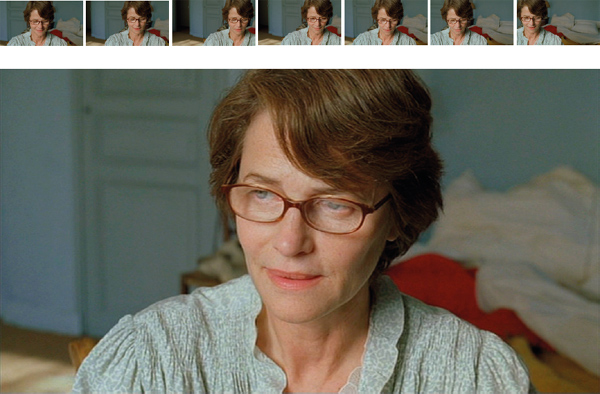
Dolly shots are commonly used to underline a meaningful moment in a scene, often when a character makes a discovery or an important decision. This dolly shot from François Ozon’s Swimming Pool (2003), the story of a mystery novel writer (Charlotte Rampling) in search of inspiration, does something quite unusual; it moves sideways instead of toward the character, indicating that something unusual is taking place besides her having a sudden burst of creativity. The audience is kept in the dark about the meaning of this shot until the end of the film, where a twist typical of the kind of novels she writes changes the context of everything they have seen.
Taking Lives. D.J. Caruso, 2004.
